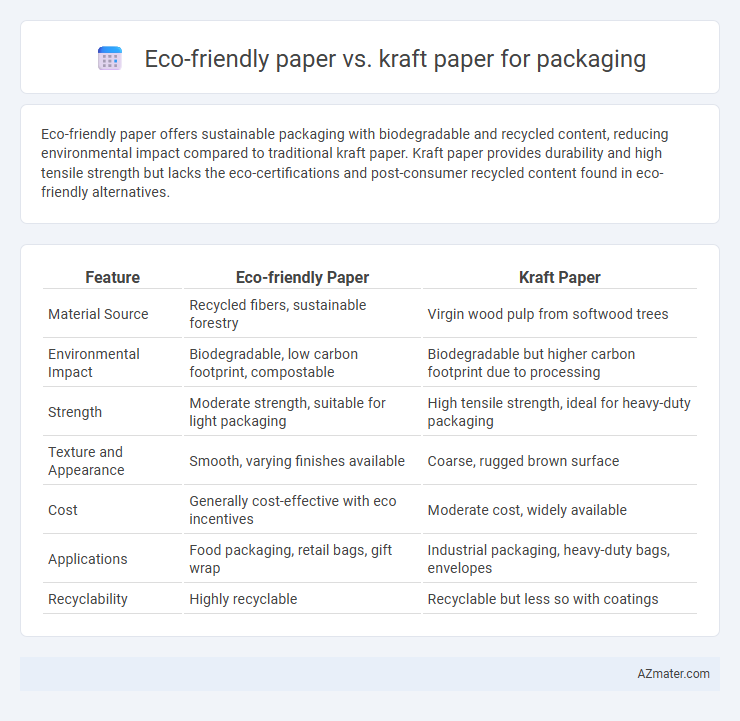Eco-friendly paper offers sustainable packaging with biodegradable and recycled content, reducing environmental impact compared to traditional kraft paper. Kraft paper provides durability and high tensile strength but lacks the eco-certifications and post-consumer recycled content found in eco-friendly alternatives.
Table of Comparison
| Feature | Eco-friendly Paper | Kraft Paper |
|---|---|---|
| Material Source | Recycled fibers, sustainable forestry | Virgin wood pulp from softwood trees |
| Environmental Impact | Biodegradable, low carbon footprint, compostable | Biodegradable but higher carbon footprint due to processing |
| Strength | Moderate strength, suitable for light packaging | High tensile strength, ideal for heavy-duty packaging |
| Texture and Appearance | Smooth, varying finishes available | Coarse, rugged brown surface |
| Cost | Generally cost-effective with eco incentives | Moderate cost, widely available |
| Applications | Food packaging, retail bags, gift wrap | Industrial packaging, heavy-duty bags, envelopes |
| Recyclability | Highly recyclable | Recyclable but less so with coatings |
Introduction to Sustainable Packaging Solutions
Eco-friendly paper offers biodegradable and recyclable qualities that reduce environmental impact, making it ideal for sustainable packaging solutions. Kraft paper, known for its strength and durability, is often produced using recycled materials, enhancing its eco-friendly profile. Both types support waste reduction and resource conservation in packaging industries focused on sustainable practices.
Defining Eco-friendly Paper: Materials and Production
Eco-friendly paper is produced using sustainable raw materials such as recycled fibers, agricultural waste, or rapidly renewable sources like bamboo and hemp, minimizing environmental impact throughout its lifecycle. Production processes emphasize reduced water usage, non-toxic bleaching agents, and energy efficiency to lower carbon footprints compared to conventional paper manufacturing. These practices result in packaging materials that are biodegradable, compostable, and suitable for eco-conscious brands seeking sustainable alternatives to kraft paper.
What is Kraft Paper? Origins and Characteristics
Kraft paper is a durable material produced from chemical pulp, known for its high tear resistance and strength, making it ideal for packaging heavy or bulky items. Originating in the late 19th century through the kraft process invented by Carl F. Dahl, it involves treating wood chips with sodium hydroxide and sodium sulfide to produce strong fibers. Characterized by its natural brown color, recyclability, and biodegradability, kraft paper remains a sustainable choice amid rising demand for eco-friendly packaging solutions.
Environmental Impact: Eco-friendly Paper vs. Kraft Paper
Eco-friendly paper packaging significantly reduces environmental impact through sustainable sourcing, biodegradability, and lower carbon emissions during production compared to conventional Kraft paper. Kraft paper, while durable and recyclable, often involves more intensive chemical processing that can result in higher environmental footprints. Choosing eco-friendly paper supports circular economy principles by minimizing resource depletion and pollution.
Biodegradability and Compostability Compared
Eco-friendly paper and Kraft paper are both valued for packaging due to their biodegradability, but eco-friendly paper often incorporates recycled fibers and natural additives that enhance its compostability. Kraft paper, made from chemically processed wood pulp, tends to possess robust durability but can degrade more slowly in compost environments compared to eco-friendly paper varieties specifically designed for rapid breakdown. Biodegradability rates and compostability certifications such as ASTM D6400 or EN 13432 typically favor eco-friendly paper options that minimize environmental impact and accelerate organic decomposition.
Strength and Durability for Packaging Needs
Eco-friendly paper for packaging typically offers moderate strength and durability, suitable for lightweight or short-term use, while Kraft paper is renowned for its high tensile strength and tear resistance, making it ideal for heavy-duty packaging. Kraft paper's natural fibers and dense composition provide enhanced protection against impacts and punctures, ensuring better durability during transport and storage. Businesses requiring robust, reliable packaging often prefer Kraft paper due to its superior structural integrity and resistance to wear.
Cost Analysis: Eco-friendly Paper vs. Kraft Paper
Eco-friendly paper often incurs higher initial costs due to sustainable sourcing and manufacturing processes, whereas kraft paper offers a more economical option with its lower production expenses and widespread availability. Despite the higher price, eco-friendly paper can reduce long-term costs by enhancing brand reputation and meeting consumer demand for sustainability. Cost analysis between these materials must consider environmental impact, durability, and potential savings from waste reduction alongside direct financial outlays.
Aesthetics and Customization Options
Eco-friendly paper offers a smooth, natural texture with a muted color palette that enhances artisanal and organic branding through eco-conscious aesthetics. Kraft paper provides a rugged, rustic appearance with rich brown hues, ideal for bold, vintage-inspired packaging designs. Both materials support versatile customization options including embossing, foil stamping, and eco-friendly printing techniques to achieve distinctive brands while maintaining sustainable appeal.
Industry Applications and Case Studies
Eco-friendly paper and kraft paper serve distinct roles in packaging, with eco-friendly paper favored in sustainable product lines for biodegradable and recycled content aimed at reducing environmental impact. Kraft paper's strength and durability have made it a staple in heavy-duty packaging, widely used in industries such as food, electronics, and e-commerce, where protection against damage and moisture is critical. Case studies from companies like Amazon showcase kraft paper's efficiency in protecting goods during transit, while brands like Lush highlight eco-friendly paper to enhance brand image and meet consumer demand for sustainable packaging solutions.
Choosing the Best Option for Your Brand
Eco-friendly paper offers sustainable qualities such as recycled content and biodegradability, making it ideal for brands prioritizing environmental responsibility. Kraft paper stands out for its durability, tear resistance, and natural brown appearance, often favored for rustic or industrial brand aesthetics. Selecting the best packaging material depends on balancing eco-conscious features with strength requirements and brand identity to enhance customer perception and product protection.

Infographic: Eco-friendly paper vs Kraft paper for Packaging
 azmater.com
azmater.com